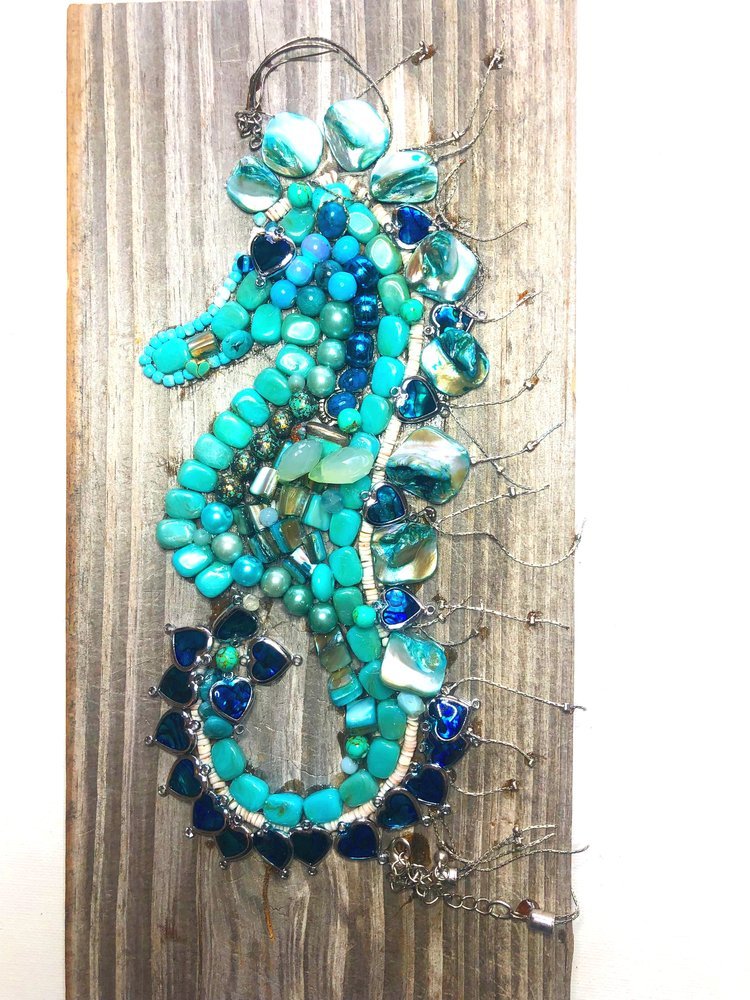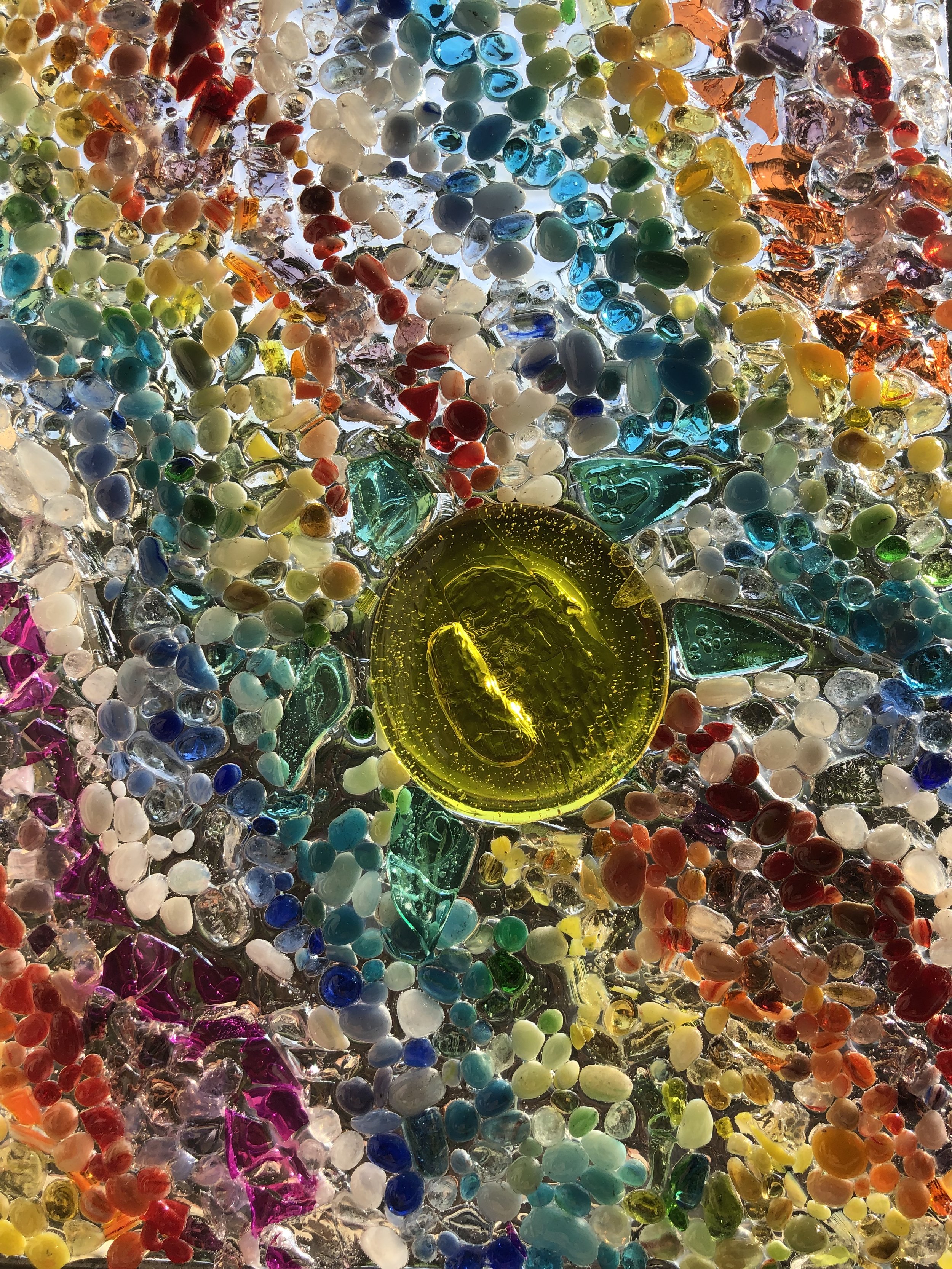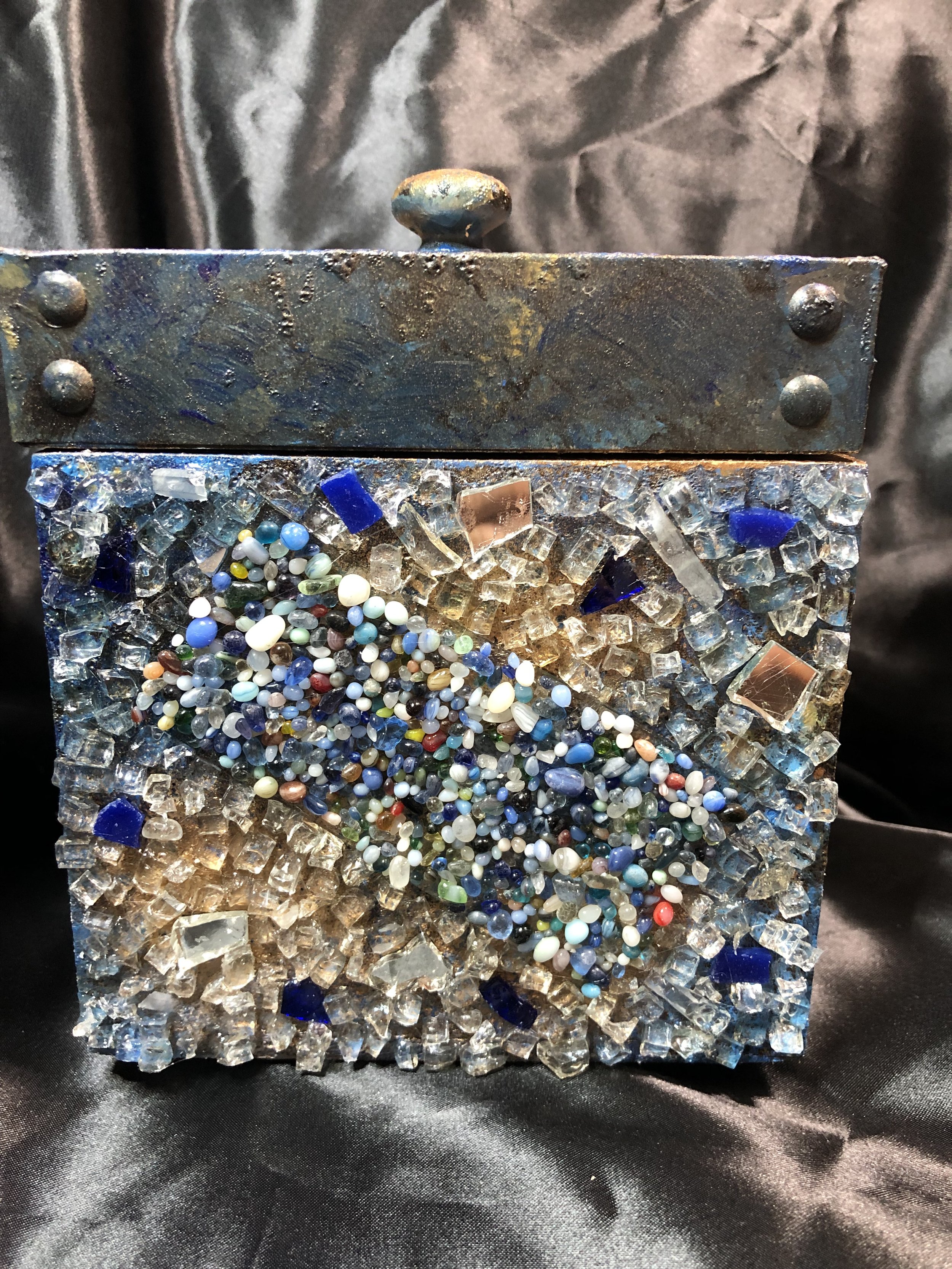Just published! A photo of my work: Purplish Seahorse in volume 19 of USF’s lit mag!
This piece is layered glass, covered in resin.
(C) Kelly Jadon, 2025
Just published! A photo of my work: Purplish Seahorse in volume 19 of USF’s lit mag!
This piece is layered glass, covered in resin.

(C) Kelly Jadon, 2025

Greater Seahorse 3, KJadon 2024; Glass & Resin, 15 x 22; Now Available
Seahorses are like people, some tall, and some short! The largest of the creatures is the Big-Bellied Seahorse, not a very romantic name, but it does give you a good visual. The Big-Bellies can grow more than one foot long! They inhabit shallow waters of Southern Australia and New Zealand.

Greater Seahorse 2, KJadon, 2024; Glass & Resin, Sold
Rather fascinatingly, the Big-Bellies can take their long tails and wind them in or wind them out, anchoring themselves to seagrass or even to other seahorses. Mating for life, a pair of Big-Bellies will hang out together for about six years down under.

Greater Seahorse 1, KJadon, 2024; Glass & Resin; Available at Do Over Decor, Jensen Beach, FL
When mating, the female will push her belly against the male’s brood pouch, at the base of his tail. She will inject 300-500 eggs through an egg duct. The brood pouch becomes a placenta, sustaining the foals with nutrients. Like all seahorses, the male carries the eggs until they are ready to swim on their own.

Greater Seahorse 3, KJadon 2024; Glass & Resin, 15 x 22; Now Available
These larger art pieces are created upon reclaimed glass shelving. This type of glass is thick and durable and able to hold the glass and resin that I layer atop.
Other pieces of glass are remnants from bottles, vases, fancy dishes, stemware and plates. I use these types of glass because they have shape, curves, texture and sometimes prints that are unusual. I especially like to place them as the crowns on the seahorses’ heads. Some small shards are leftovers from other artists’ stained glasswork. Approximately 99% of my art is eco-art, utilizing repurposed and recycled glass. It arrives from friends, thrift shops and a garage sale or two!
See my Stone, Shell and Jewelry Art! Paintings Smaller Glass Pieces
Artwork Available Locally at Do Over Decor and Sand & Sea Boutique
(C) Kelly Jadon, 2024

Panoramic View of Biscayne Bay, Wikipedia, CC Lic.
Last week I spoke to a visitor to Jensen Beach. He and his wife were in Martin County looking for an affordable home on the water. They wanted to get out of Miami. At the time, we were in the Sand & Sea Boutique on the Indian River. I spoke up when I saw him looking at my seahorse creations.
A well-spoken man, he told me about his former profession—a shrimper in Biscayne Bay during the 1980s. As he netted shrimp, he’d also netted seahorses, pulling them up from their anchors in tropical waters. The shrimper said that if he’d thrown the seahorses back, they wouldn’t have survived, so he’d donated many of them to a local city aquarium.
The seahorses, he stated, were every color of the rainbow.
Biscayne Bay is a subtropical lagoon, a shallow with meadows of seagrass and corals, to the east of Miami. The north end of the bay is home to downtown Miami. The southern portion of the lagoon is a part of Biscayne National Park and is pretty much undeveloped. It’s about 35 miles long, heading south into the upper Florida Keys.
Three types of seahorses inhabit Biscayne Bay.
Seahorses caught in fishing nets dragged on the bottom of the lagoon, are known as “bycatch.” Trawl fishing is a danger to the creatures.
In 2018, Emilie Stump, a Project Seahorse artist and writer, wrote about the continued live-bait shrimping in Biscayne Bay. According to a 1997 University of Miami report, the trawls cause “substantial damage to potential seahorse holdfasts.” Seahorses use their lengthy tails to anchor themselves to these corals at the lagoon bottom. Dr. Joe Serafy published a survey in 1997 revealing that “roller-frame trawls are also known to catch at least eight species of seahorse or pipefish in Biscayne National Park as bycatch.” In addition, Dr. Julia Baum published research, estimating “72,000 lined seahorses per year” are bycatch from 31 trawlers off Hernando Beach, in the Gulf of Mexico.
It is important to recognize the dangers of trawling to seahorses because these creatures are the health marker of our coastal seas. If they are protected, our Florida waters will survive and thrive.
How do coastal waters retain their naturalness when more than 22 million and a half people live on its periphery?
President Lyndon B. Johnson signed a law to create Biscayne National Monument in 1968. It was expanded in 1974, and again in 1980 when Congress created Biscayne National Park in 1980.
Yet the bait shrimp trawling was continued to be permitted in Biscayne Bay. Why?
In 1974, the Florida Legislature created the Biscayne Bay Aquatic Preserve. In 1975, it created the Biscayne Bay-Cape Florida to Monroe County Line Aquatic Preserve.
The waters directly around the State of Florida belong to Florida, therefore, the responsibility of maintaining them, belongs to the State. Who is the State of Florida? Florida residents are. It is the responsibility of Florida residents to make sure that their coastal waters survive. Leaders are elected and put in place to accomplish these things.
The current Director of the Florida Fish and Wildlife Conservation Commission’s Division of Marine Fisheries Management is Jessica R. McCawley.
Shrimp trawling around the coastal waters of Florida continues to be permitted. Why?
Laws were necessary in the past to preserve large areas of coastal waters. Laws must be made and updated to protect coastal areas around Florida where seahorses live. They are the flagship of our waters’ health. As seahorses are protected, coastal seas will be preserved for future generations.

Dwarf Seahorse, KJadon, 2024, Available At Sand & Sea Boutique, Jensen Beach, FL
© Kelly Jadon, 2024

Lined Seahorse Blue Heron Bridge, FL 6/19/11 Spectacular seahorse. Looked dull brown before lit up with the strobes. He was hauling ass (if a seahorse can) across the bottom. By Matt Sullivan from Boston, MA, USA, Wikipedia, CC Lic.
Several years ago, my husband and I were out on Hutchinson Island on the dock across the street from the House of Refuge. A man was there netting fish. On this occasion, he’d also caught a seahorse! There are in fact, three different types of seahorses native to Floridian waters.
I’ve recently read Seahorses: A Life-Size Guide to Every Species by Sara Lourie. The author has a Ph.D. in the science of seahorses and has made their study and preservation her life’s work. Fascinating!

Dwarf Seahorse by Will Thomas, Wikipedia, CC. Lic.
In the world, there are approximately 50 various types of seahorse. The tiniest may be the size of a bean!
Often, their colors blend with their environment for protection. Their camouflage normally includes mottling, spots, and stripes. They have crowns, little frills, and points like spikes. The creatures swim slowly in an upright position, and are usually found in coastal waters anchored by their tails to seagrass, mangroves, coral, etc.. Their long snouts are used to suction in tiny invertebrates.
During courtship, they are seen waltzing.
The male seahorse will carry fertilized eggs and then give birth to them. How many? Some seahorses birth thousands!

Aqua Jeweled Seahorse, Kelly Jadon 2024, Available at Sand & Sea 3/21/24
Currently, I’m creating a series of seahorses. They can be viewed or purchased at the Sand & Sea Boutique in Jensen Beach, Florida.
This Dwarf Seahorse is found around the Florida Keys!

Dwarf Seahorse, Layered Stained Glass, Resin Finish Kelly Jadon, 2024
(C) Kelly Jadon

Resplendent Quetzal, By Supreet Sahoo - Own work, CC BY-SA 4.0, https://commons.wikimedia.org/w/index.php?curid=58173977
The Guatemalan mountains shrouded in cloud cover are home to the Resplendent Quetzal. This bird makes its home in the canopy of the rainforests at very high altitudes.
During ancient times, the Mayan people prized the rare green tail feathers of the Quetzal, using them as a form of exchange. This idea persisted into modern Guatemalan culture with the currency of Guatemala called a “Quetzal.” The beautiful bird is also the national bird of Guatemala.

Resplendent Quetzal, Kelly Jadon—Glass and Resin, 2024, For Sale
In this piece I created an artistic rendering of a Resplendent Quetzal using glass beads for the layered mosaics of the bird and the flowers. A large piece, it is covered in resin. It is for sale in my studio.
If you'd like to see it in person or host it for a time on loan, please contact me. Thank you!
(C) Kelly Jadon 2024

“Pinky 2” Glass and Resin, Kelly Jadon, 2024
In the Gulf of Mexico, along the coast of Louisiana, a pink dolphin or two skim waves, bottlenosing into the depths again. One in particular is known as “Pinky.” Some scientists believe that she has a genetic mutation causing her pinkish hue. Other biologists think she may be an albino dolphin. She, however, is a delight to those who catch a glimpse of her.
Pinky lives in a pod of normal grayish colored bottlenose dolphins. Recently, she was seen with her own little pinky calf.
Artists love color. My dolphin projects are specifically chosen to highlight the need to protect these water mammals, especially those which garner public attention.

“Dolphins” Glass and Resin, Kelly Jadon, 2023
The Sarasota Dolphin Research Program explains that as the waters of the Gulf of Mexico increase in temperature, it is not uncommon to notice in summer months, that dolphins will have a pinkish color, known as “blushing” on their underbelly. Beings mammals, they too get hot and need a way to release excess heat. Humans can sweat. Because the creatures live under water, they cannot perspire. Their excess heat is given off by sending it to the outer perimeter of their bodies where it comes into contact with the cooler water. This creates the “blush” on the bellies of dolphins.
Rose-hued dolphins can be seen off the coasts of Louisiana, Florida and Texas.
(C) Kelly Jadon, 2024

Pinky Two, Kelly Jadon, Glass and Resin, 2024
Where do I get these strange ideas—breaking up glass to make something new? I really don’t know. I just look at a piece of glassware—a teacup, a vase, a plate—and I think, “Could I do something with this?”

One of my scrap boxes
“Will the color work for a seahorse, a dolphin, or waves?”

I recently completed this piece, “Pinky Too,” a second repurposed dolphin glass sculpture. The dolphins are dimensional mosaics made of tiny pieces. The waves are a recycled vase or two with crushed glass applied to the tips. The dolphins are positioned, as jumping out of a long conical vase that’s been turned on its side. Little circular glass pieces adorn the entire piece, as if they are water bubbles.
Beneath the glass bricks is the base—a former glass picture frame.
I take cutters and break the glass into the shapes I need. For Christmas, I received a special pair of gloves to protect my hands while completing this task. Who’d have thought there was such a thing? :)
At times, I need very tiny pieces of glass. My cuttings are saved for this very purpose. Some of it is so small, it looks like its sand.

(C) Kelly Jadon 2024

“Resplendent Quetzal” Kelly Jadon, 2024, Glass, Resin
You see me,
my feathers, my tail, flitting far from my head
my influence flying over seas
far from me
You see me,
my rich royal colors alluring all to come and see
what I offer
but like a mirage
I am not what you see
but am as brown as the earth
my blood, the same as others
tinged
and like the others
have followed after falseness
an illusion
a mirage
of what is not really there
[The Resplendent Quetzal appears as a very colorful bird, but its plumage is actually brown.]

(C) Kelly Jadon, 2024

You can now find pieces of my artwork, those related to beautiful South Florida's beach and waves at Sand & Sea, a handmade boutique where Jensen Beach deadends at the Indian River in downtown Jensen. Come by and see the store! Let me know what you think.
Thanks!
Kelly Jadon

National Christmas Trees, Kelly Jadon, 2023 (The White Fir is sold.)
What’s in a Christmas tree? Hopes for a happy year’s ending? Or the beginning of something new and fresh?
Each time I draw together pieces of glass to cut, smooth and place, I hope to begin something new and unique, non-standard, even, dare I say it, “imperfect.”
A perfect tree isn’t true to a natural habitat. It has flaws. Has repelled attacks. Yet, it is regarded as “just right,” and is adorned by the good works of its purchaser.
Each one, perfectly imperfect.

A Forest of Christmas Trees, Kelly Jadon, 2023, SOLD
If you’d like sneak peeks before released to the general public, please subscribe to the newsletter HERE.
(C) Kelly Jadon, 2024

Pinky! A Gulf Dolphin--multi-dimensional mosaic of layered fused glass; Kelly Jadon, 2023, For Sale: Available at Sand & Sea Boutique: 3291 NE Indian River Drive, Jensen Beach
This place is where i came to
i remember
where God’s power roars
beating against rock strewn with holes
driven over by sea and salt
its taste touches my tongue
my lips
blurring ink upon paper
like tears and wet mascara
a distant ship edges over morning’s horizon
bahama bound
gently, winter’s waves gentle to calm
a hello peaks
the curve of rise and dive
rise and dive repeats, repeats
the quiet greeting
the hello each morn
dolphins near the shore
(C) Kelly Jadon 2023

Rainbow Seahorse, mosaic of stained glass, fused, layered, resin, 6” X 8”, Kelly Jadon, 2023. Received as a Member Spotlight Submission by the Stained Glass Association of America. For Sale: Available at Sand & Sea Boutique: 3291 NE Indian River Drive, Jensen Beach
Life flows as river currents
yet we hold to what is good
what is secure
embedded in river’s bed
(C) Kelly Jadon, 2023




Treasure Coast dolphins visit daily, cruising through shorelines and inlets. Fused and layered glass with resin, 9x11. (C) Kelly Jadon, 2023

Sea Turtle Mosaic--glass, resin, 5x7, signed by artist, Kelly Jadon, 2023--FOR SALE: Available at Sand & Sea Boutique: 3291 NE Indian River Drive, Jensen Beach
Each year tiny hatchlings hear the wash of waves upon sand’s shallow shore
energetic eyes adjust to dawn’s light,
drawing them further down slope’s descent,
into waves’ swooshing waters
as younglings, they keep near seabed grasses for sustenance
they see, and are seen
(C) Kelly Jadon, 2023

Pineapple Mosaic, Kelly Jadon, 2023, SOLD—Glass, Layered, Resin
(C) Kelly Jadon, 2023

Cremation Urn for Pet Dog, Kelly Jadon, 2023, SOLD


(C) Kelly Jadon, 2023


Seahorse Sealife—stained glass, fused, layered, Kelly Jadon, 2023 SOLD



Hummers Take Flight: The hummingbirds that winter in Florida have flown north for the summer’s zinnias. The base of this stained piece is glass, painted with acrylic used a fluid technique. Parts of the layered glass mosaic are fused. For Sale at $75.00
(C) Kelly Jadon, 2023

“Butterfly Garden” Kelly Jadon, 2023, SOLD

Butterfly Garden, Kelly Jadon, 2023, SOLD

Approximately 200 types of butterflies migrate through Florida, while more than 160 kinds breed in the state. Some of these butterflies are only found in Florida within the continental United States.

(C) Kelly Jadon, 2023 “In Flight” For Sale

(C) Kelly Jadon, 2023 “In Flight” For Sale

(C) Kelly Jadon, 2023 “In Flight” For Sale
(C) KELLY JADON 2025